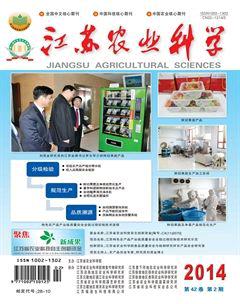红掌FLOWERING LOCUS T同源基因的克隆及生物信息学分析
马广莹+邹清成+刘慧春+周江华+朱开元
摘要:通过高通量测序技术获得红掌成花素基因FT,对其进行序列分析,通过与已报道同源基因的比较,预测基因FT能够显著促进转基因植物开花,为开展红掌分子育种提供了有益基因资源。
关键词:红掌;克隆;基因FT;信息学;序列分析
中图分类号: S682.03文献标志码: A文章编号:1002-1302(2014)02-0031-02
收稿日期:2013-06-18
基金项目:国家自然科学基金(编号:31200527);浙江省自然科学基金(编号:Q13C150011)。
作者简介:马广莹(1982—),男,山东梁山人,博士,助理研究员,从事园林植物引种栽培及遗传育种工作。E-mail:magypetunia@aliyun.com。为实现种群繁衍,植物必须在合适的时间进行生殖生长、开花结果。许多植物调整开花时间的方式是根据环境信号(如日照长短、温度等)来产生应答反应,植物内源激素和年龄这2个内部信号也可以诱导植物开花。近年来,通过对模式植物拟南芥的分子水平研究,人们总结出“光周期、春化、自主调控以及赤霉素”4条控制植物开花的途径[1-3]。FLOWERING LOCUS T基因(FT基因)是学术界普遍认可的成花素,于叶片中合成,然后通过韧皮部运输到顶端分生组织,FT与FD基因互作,诱导下游成花基因的表达,促进开花[4-5]。
拟南芥(Arabidopsis thaliana)中存在6类FT-like基因,都可能参与了成花诱导,这些基因有着共同的PEPB结构域[6]。本研究经转录组测序,克隆到了1个红掌(Anthurium andraeanum)PEPB基因,通过序列对比等生物信息学分析,确定该基因是1种促进开花的功能基因,这为今后通过转基因手段培育矮化的早花红掌品种、缩短红掌育种年限提供了重要的资源。
1材料与方法
1.1试验材料
红掌品种为“阿拉巴马”,取盛花期植株幼嫩叶片、苞片、花序3个组织进行混合,按照美国Invitrogen公司生产的植物RNA提取试剂盒(货号:12322-012)提取总RNA,构建Illumina文库,并委托上海美吉生物公司采用Illumina Hiseq 2000对文库进行测序。
1.2序列分析软件及分析方法
通过测序获得的基因序列,经过NCBI 网站ORFFinder软件进行编码区预测,然后用http://prosite.expasy.org/网站进行编码区氨基酸序列预测,并进行序列保守结构域的检索[7],采用DNAMAN软件进行多序列氨基酸比对,采用MEGA5进行多物种FT基因进化关系分析[8],建树方法为Neighbor-joining,bootstrap 1 000次。
2结果与分析
2.1红掌FT基因获得
通过测序,获得了与水稻FT基因相似度较高的1条EST序列,通过比对分析,初步确定其为红掌FLOWERING LOCUS T基因的同源物,命名为AaFT。如图1所示,该基因编码区核苷酸序列有525 bp,其余部分为UTR区域。用该区域序列进行氨基酸推测,得到了174个氨基酸残基。
2.2AaFT基因生物信息学分析
通过在线软件分析,不仅推测出该基因的氨基酸序列,还找到了该序列中存在PBP结构域所在的位置,该结构域共计23个氨基酸残基,序列为YTLVMVDPDAPSPSDPNLREYLH,起始位置为64~86号氨基酸。
为了更好地分析该基因的保守性及与同类基因的相似度,将其与拟南芥FT基因(AtFT)进行序列比较。由图2可见,拟南芥与红掌FT基因的序列相似度比较高,二者在FT基因关键氨基酸残基上有着相同的组成,即第85、140号氨基酸残基分别为酪氨酸、谷酰胺。
用MEGA软件构建了6种不同物种FT基因的进化树。从图3可见,单、双子叶植物FT基因同源性差异明显,属于单子叶植物的红掌与水稻(Oryza sativa,登录号:AB052943.1)、蕙兰(Cymbidium faberi,登录号:KC138734.1)、蝴蝶兰(Phalaenopsis hybrid,登录号:KC138805.1)、小麦(Triticum aestivum,登录号:AY705794.1)亲缘关系较近,聚类时容易聚在一起,而红掌FT基因与拟南芥相比,亲缘关系则明显较远,这也与二者分属单、双子叶植物类别相对应。
3小结与讨论
FT基因作为成花素,受到广泛关注,目前,已经有非常多植物的FT基因被成功克隆出来,在促进植物开花方面表现十分优异[9]。红掌作为国内外重要的高档盆栽花卉,目前育种工作主要集中在常规杂交育种方面,分子育种刚刚起步,红掌FT基因的克隆为通过转基因手段快速培育红掌新品系、缩短杂交育种年限提供了有利条件,也为微型红掌品种的开发提供了可能。
本试验通过高通量测序技术获得了1条包含完整编码框的FT基因序列,通过比对及生物信息学分析,确定该基因为红掌FT同源基因。前人研究证明,FT基因家族存在着序列高度相似、功能完全相反的成员——TFL[10-11],但是二者在关键氨基酸组成上存在着明显区别,通过比较分析,本研究所克隆的基因序列在85号及140号氨基酸组成上与拟南芥促进早花的FT基因完全一致,结合相似序列,确定该基因是FT基因,其功能应该是促进植物开花,而非抑制植物开花。
用红掌FT基因与拟南芥比较,虽然二者分属于单、双子叶植物类别,但是两基因在氨基酸组成的高度相似说明了FT基因在进化过程中保持着稳定性,这可能是其发挥早花功能的必备条件。与多物种FT基因进行聚类分析,发现红掌FT基因与其他单子叶植物之间存在着较大遗传距离,说明FT基因虽然功能上保持着稳定性,但随着物种的进化而不断发生变异,深入研究该基因及其家族成员,有利于解析不同物种的进化模式。
参考文献:
[1]Simpson G G,Gendall A R,Dean C. When to switch to flowering[J]. Annual Review of Cell and Developmental Biology,1999,15(1):519-550.
[2]Reeves P H,Coupland G. Response of plant development to environment:control of flowering by daylength and temperature[J]. Current Opinion in Plant Biology,2000,3(1):37-42.
[3]Simpson G G,Arabidopsis D C. Arabidopsis,the rosetta stone of flowering time[J]. Science,2002,296(5566):285-289.
[4]Abe M,Kobayashi Y,Yamamoto S,et al. FD,a bZIP protein mediating signals from the floral pathway integrator FT at the shoot apex[J]. Science,2005,309(5737):1052-1056.
[5]Hanzawa Y,Money T,Bradley D. A single amino acid converts a repressor to an activator of flowering[J]. Proceedings of the National Academy of Sciences of the United States of America,2005,102(21):7748-7753.
[6]Chardon F,Damerval C. Phylogenomic analysis of the PEBP gene family in cereals[J]. Journal of Molecular Evolution,2005,61(5):579-590.
[7]Artimo P,Jonnalagedda M,Arnold K,et al. ExPASy:SIB bioinformatics resource portal[J]. Nucleic Acids Research,2012,40:W597-W603.
[8]Tamura K,Peterson D,Peterson N,et al. MEGA5:molecular evolutionary genetics analysis using maximum likelihood,evolutionary distance,and maximum parsimony methods[J]. Molecular Biology and Evolution,2011,28(10):2731-2739.
[9]Kotoda N,Hayashi H,Suzuki M,et al. Molecular characterization of FLOWERING LOCUS T-like genes of apple(Malus domestica Borkh.)[J]. Plant & Cell Physiology,2010,51(4):561-575.
[10]Ahn J H,Miller D,Winter V J,et al. A divergent external loop confers antagonistic activity on floral regulators FT and TFL1[J]. Embo Journal,2006,25(3):605-614.
[11]Mimida N,Goto K,Kobayashi Y,et al. Functional divergence of the TFL1-like gene family in Arabidopsis revealed by characterization of a novel homologue[J]. Genes to Cells,2001,6(4):327-336.
参考文献:
[1]Simpson G G,Gendall A R,Dean C. When to switch to flowering[J]. Annual Review of Cell and Developmental Biology,1999,15(1):519-550.
[2]Reeves P H,Coupland G. Response of plant development to environment:control of flowering by daylength and temperature[J]. Current Opinion in Plant Biology,2000,3(1):37-42.
[3]Simpson G G,Arabidopsis D C. Arabidopsis,the rosetta stone of flowering time[J]. Science,2002,296(5566):285-289.
[4]Abe M,Kobayashi Y,Yamamoto S,et al. FD,a bZIP protein mediating signals from the floral pathway integrator FT at the shoot apex[J]. Science,2005,309(5737):1052-1056.
[5]Hanzawa Y,Money T,Bradley D. A single amino acid converts a repressor to an activator of flowering[J]. Proceedings of the National Academy of Sciences of the United States of America,2005,102(21):7748-7753.
[6]Chardon F,Damerval C. Phylogenomic analysis of the PEBP gene family in cereals[J]. Journal of Molecular Evolution,2005,61(5):579-590.
[7]Artimo P,Jonnalagedda M,Arnold K,et al. ExPASy:SIB bioinformatics resource portal[J]. Nucleic Acids Research,2012,40:W597-W603.
[8]Tamura K,Peterson D,Peterson N,et al. MEGA5:molecular evolutionary genetics analysis using maximum likelihood,evolutionary distance,and maximum parsimony methods[J]. Molecular Biology and Evolution,2011,28(10):2731-2739.
[9]Kotoda N,Hayashi H,Suzuki M,et al. Molecular characterization of FLOWERING LOCUS T-like genes of apple(Malus domestica Borkh.)[J]. Plant & Cell Physiology,2010,51(4):561-575.
[10]Ahn J H,Miller D,Winter V J,et al. A divergent external loop confers antagonistic activity on floral regulators FT and TFL1[J]. Embo Journal,2006,25(3):605-614.
[11]Mimida N,Goto K,Kobayashi Y,et al. Functional divergence of the TFL1-like gene family in Arabidopsis revealed by characterization of a novel homologue[J]. Genes to Cells,2001,6(4):327-336.
参考文献:
[1]Simpson G G,Gendall A R,Dean C. When to switch to flowering[J]. Annual Review of Cell and Developmental Biology,1999,15(1):519-550.
[2]Reeves P H,Coupland G. Response of plant development to environment:control of flowering by daylength and temperature[J]. Current Opinion in Plant Biology,2000,3(1):37-42.
[3]Simpson G G,Arabidopsis D C. Arabidopsis,the rosetta stone of flowering time[J]. Science,2002,296(5566):285-289.
[4]Abe M,Kobayashi Y,Yamamoto S,et al. FD,a bZIP protein mediating signals from the floral pathway integrator FT at the shoot apex[J]. Science,2005,309(5737):1052-1056.
[5]Hanzawa Y,Money T,Bradley D. A single amino acid converts a repressor to an activator of flowering[J]. Proceedings of the National Academy of Sciences of the United States of America,2005,102(21):7748-7753.
[6]Chardon F,Damerval C. Phylogenomic analysis of the PEBP gene family in cereals[J]. Journal of Molecular Evolution,2005,61(5):579-590.
[7]Artimo P,Jonnalagedda M,Arnold K,et al. ExPASy:SIB bioinformatics resource portal[J]. Nucleic Acids Research,2012,40:W597-W603.
[8]Tamura K,Peterson D,Peterson N,et al. MEGA5:molecular evolutionary genetics analysis using maximum likelihood,evolutionary distance,and maximum parsimony methods[J]. Molecular Biology and Evolution,2011,28(10):2731-2739.
[9]Kotoda N,Hayashi H,Suzuki M,et al. Molecular characterization of FLOWERING LOCUS T-like genes of apple(Malus domestica Borkh.)[J]. Plant & Cell Physiology,2010,51(4):561-575.
[10]Ahn J H,Miller D,Winter V J,et al. A divergent external loop confers antagonistic activity on floral regulators FT and TFL1[J]. Embo Journal,2006,25(3):605-614.
[11]Mimida N,Goto K,Kobayashi Y,et al. Functional divergence of the TFL1-like gene family in Arabidopsis revealed by characterization of a novel homologue[J]. Genes to Cells,2001,6(4):327-336.

